GATE EE 2020 Solved Paper
GA- General Aptitude
Q.1-Q.5 carry one marks each.
Q.1.This book, including all its chapters,_ interesting. The students as well as the instructor in agreement about it.
(A) is, was
(B) are, are
(C) is, are
(D) were, was
Ans. (C) is, are
Solution: is and are are required in the given blanks. is is used for singular verb and are is for plural.
Therefore, option (c) is correct.
Q.2. People were prohibited_______ their vehicles near the entrance of the main administrative building.
(A) to park
(B) from parking
(C) parking
(D) to have parked
Ans. (B) from parking
Solution: The preposition from is perfect in the given problem. So, option (c) is correct.
Q.3. Select the word that fits the analogy:
Do:Undo::Trust:
(A) Entrust
(B) Intrust
(C) Distrust
(D) Untrust
Ans. (C) Distrust
Solution: Taking antonyms of the following words, The opposite of do is undo and opposite of trust is distrust. So, option (c) is correct.
Q.4. Stock markets _ at the news of the coup.
(A) poised
(B) plunged
(C) plugged
(D) probed
Ans. (B) plunged
Solution: The option (b) fits in the given problem. Plunged means jump or drive quickly.
Q.5. If P,Q,R,S are four individuals, how many teams of size exceeding one can be formed, with Q as a member?
(A) 5
(B) 6
(C) 7
(D) 8
Ans. (C) 7
Solution: Applying formula of combination,
^{n}C_{r}=frac{n!}{r!(n-r)!}Taking Combination of these four individuals , we get
3C1+3C2+3C3
3 + 3+ 1 = 7
So, there could be 7 possible combinations. The combinations could be,
PQ, RQ, SQ, PRQ, PSQ, RSQ, PQRS
So, option (c) is correct.
Q.6-Q.10 carry two marks each.
Q.6. Non-performing Assets(NPAs) of a bank in India is defined as an asset, which remains unpaid by a borrower for a certain period of time in terms of intyerest, principal, or both. Reserve Bank of India(RBI) has changed the definition of NPA thrice during 1993-2004, in terms of the holding period of loans. The holding period was reduced by one quarter each time. In 1993, the holding period was four quarters(360 days).
Based on the above paragraphs, the holding period of loans in 2004 after the third revision was __ days.
(A) 45
(B) 90
(C) 135
(D) 180
Ans. (B) 90
Solution: It is given in the problem that holding period was reduced by one quarter each time. It means there are four quarters i.e. 360 days., so as holding period is reduced by one quarter.
Therefore, Holding period = 360/4 = 90 days
So, after third revision holding period of loans in 2004 remains 90 days.
Q.7. Select the next element of the series: Z,WV,RQP,
(A) LKJI
(B) JIHG
(C) KJIH
(D) NMLK
Ans. (C) KJIH
Solution: Applying the logic like,
Let us assume that each alphabet is numbered 1,2, till 26 .
i.e. A=1, B=2… Z=26
We can see that number is firstly reduced by 3, 2 then 1
Z = 26
WV = 23 , 22
RQP = 18, 17, 16
KJIH = 11, 10, 9 , 8
So, option (c) is correct.
Q.8. In four-digit integer numbers from 1001 to 9999, the digit group ”37”( in the same sequence) appears __ times.
(A) 270
(B) 279
(C) 280
(D) 299
Ans. (B) 279
Solution: The given four digit number is 1001 to 9999.
10 x 10 + 9 x 10 + 9 x 10 = 280
So, 37 appears 280 times
So, option (c) is correct.
Q.9. Given a semicircle with O as the centre, as shown in the figure the ratio frac{overline{AC}+overline{CB}}{overline{AB}} is _, where overline{AC},overline{CB};and;overline{AB} are chords.
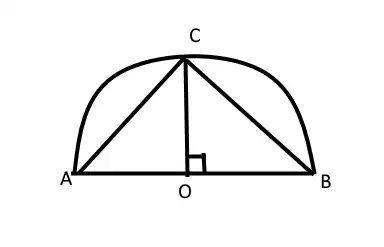
(A)√2
(B) √3
(C) 2
(D) 3
Ans. (A)√2
Solution: Given that O is the centre of the semicircle. Let AB is the diameter of the semicircle.
Let OC = r , OB= r , AO=r
Applying pythagoras theorem, to the triangle OCA and OCB
We get AC=BC = sqrt{2}r
The ratio is frac{overline{AC}+overline{CB}}{overline{AB}}= frac{overline{AC}+overline{CB}}{overline{AB}}
=frac{sqrt{2}r+sqrt{2}r}{2r} =frac{2sqrt{2}}{2}=sqrt{2}Therefore, option (a) is correct
Q.10. The revenue and expenditure of four different companies P,Q, R AND S in 2015 are shown in the figure. If the revenue of company Q in 2015 was 20% more than that in 2014, and company Q had earned a profit of 10%on expenditure in 2014, then its expenditure(in million rupees) in 2014 was __.
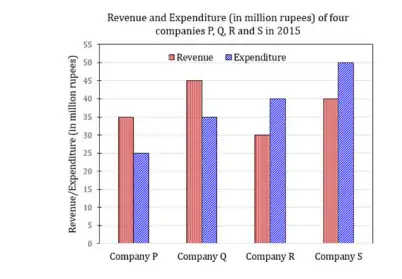
(A) 32.7
(B) 33.7
(C) 34.1
(D) 35.1
Ans. (C) 34.1
Solution: From the figure , the data of four companies is given. let the revenue of company Q in 2014 is Rs. x million rupees.
It is mentioned that revenue of company Q in 2015 was 20% more than that in 2014.
The revenue of Company Q in 2015 is Rs. 1.2 x milion rupees
So, 1.2 x = 45
x = 37.5 in million rupees
The second condition given is that Q has earned 10% profit .
Since, Expenditure of company Q in 2014 = frac{x}{1.2-0.1} = frac{37.5}{1.1}=34.1
Therefore,option (c) is correct.
Q.1. ax3 + bx2 + cx + d is a polynomial on real x over real coefficients a, b,c,d wherein a ≠ 0. Which of the following statements is true?
(A) d can be chosen to ensure that x = 0 is a root for any given set a,b,c.
(B) No choice of coefficients can make all roots identical
(C) a, b, c, d can be chosen to ensure that all roots are complex.
(D) c alone cannot ensure that all roots are real
Ans. A OR D
Solution: The given polynomial is ax3+bx2+cx+d , Here a is not equal to 0
When d = 0 , the above equation becomes
ax3+bx2+cx=0
x(ax2+bx+c) = 0
So, from this it is clear that x=0 is a root for any given set a,b,c
Therefore, statement one is correct.
Q.2 Which of the following is true for all possible non-zero choices of integers m,n;m ≠n, or all possible non-zero choices of real numbers p, q; p≠ q, as applicable?
(A) frac{1}{pi }int_{0}^{pi } sinmtheta sin ntheta dtheta =0
(B) frac{1}{2pi }int_{-pi /2}^{pi /2}sinptheta sinqtheta dtheta =0
(C) frac{1}{2pi }int_{-pi }^{pi }sinptheta sinqtheta dtheta =0
(D) lim_{alpha rightarrow infty }frac{1}{2alpha }int_{-alpha }^{alpha }sin ptheta sinqtheta dtheta
Ans. (C) frac{1}{2pi }int_{-pi }^{pi }sinptheta sinqtheta dtheta =0
Solution: Let us check by putting one by one options
Firstly Consider option (A)
frac1piint_0^pisin mthetacos ntheta=0Put l = π in rule 4
int_0^pisinleft(frac{npi x}piright)sinleft(frac{mpi x}piright)dxGiven that, m ≠ n
frac1piint_0^pisin nx;sin mx;dx=0Now, Consider option (B)
frac1{2pi}int_0^pisin ptheta;sin qtheta;dtheta=0 int_{-pi}^pisinleft(frac{npi x}piright);cosleft(frac{mpi x}piright);dxGiven that, m ≠ n
int_{-pi}^pisin nxcos mxdx=0(C):
underset{alpharightarrowinfty}{Lt}frac1{2alpha}int_{-alpha}^alphasinrhothetasin qtheta;dtheta=0When, α ⟶ ∞
frac1{2alpha}int_{-alpha}^alphasinrhothetasin qtheta;dtheta=frac1infty(finite)=0So, from this all option we conclude that the option (c) is true for all possible non-zero choices of integers m,n;
Q. 3 Which of the following statements is true about the two sided Laplace transform?
(A) It exists for every signal that may or may not have a Fourier transform.
(B) It has no poles for any bounded signal that is non-zero only inside a finite time interval.
(C) The number of finite poles and finite zeroes must be equal.
(D) If a signal can be expressed as a weighted sum of shifted one sided exponentials, then its Laplace Transform will have no poles.
Ans. (B) It has no poles for any bounded signal that is non-zero only inside a finite time interval.
Solution: The value at which x(s)=0 are the zeros of x(s)
The value at which x(s) = infinity are the poles of x(s)
For bounded inputs i.e. finite-amplitude where finite width signal , the ROC is entire s plane and ROC i.e. Region of Convergence never includes any pole. Therefore, it impliesfor such signals there are no poles.
Therefore, the given statemnet is correct.
Q.4 Consider a signal x[n] = frac{1}{2}^{n}1[n], where 1[n] = 0 if n < 0, and 1 [n] = 1 if n≥0. The z-transform of x[n-k], k> 0 is frac{z^{-k}}{1-frac{1}{2}z^{-1}} with region of convergence being
(A) |Z| < 2
(B) |Z|> 2
(C) |Z| < 1/2
(D) |Z]> 1/2
Ans. (D) |Z]> 1/2
Solution: The given signal is x[n] = frac{1}{2}^{n}1[n],
The region of convergence of x(n) = |z| > frac{1}{2}
Given is the z transform of x(n-k) is
frac{z^{-k}}{1-frac{1}{2}z^{-1}}, The region of converegence of x(n-k)= |z| > 1/2
So, from this we get the ROC of x(n-k) is |z| > 1/2
So, option (d) is corrcet.
Q.5 The value of the following complex integral, with C representing the unit circle centered at origin in the counterclockwise sense, is:
int _{c}frac{z^{2}+1}{z^{2}-2z}dz(A) 8πi
(B) -8πi
(C) – πi
(D) πi
Ans. (C) – πi
Solution: The given integral is int _{c}frac{z^{2}+1}{z^{2}-2z}dz
Here, C is |z| = 1
Solving the integral
int _{c}frac{z^{2}+1}{z(z-2)}dzNow, dividing numerator and denominator with z-2
int {C}frac{frac{z^{2}+1}{z-2}}{frac{z(z-2)}{z-2}}= int {C}frac{frac{z^{2}+1}{z-2}}{z}dzBy formula of integral
f(z)=frac{z^{2}+1}{z-2})=2pi ileft ( frac{1}{-2} right )=-pi if(z) = – πi
Therefore, option (c) is correct answer.
Q.6 xR and xA are, respectively, the rms and average values of x(t) = x(t – T), and similarly, yR and yA are, respectively, the rms and average values of y(t) = k x(t).k, T are independent of t. Which of the following is true?
(A) yA = kxA; YR = kxR
(B) yA = kxA; YR #kxR
(C) yA ≠kxAi YR = kxR
(D) yA ≠ kxA; YR ≠ kxR
Ans. (A) yA = kxA; YR = kxR
Solution: We know that xA and xB are the rms and average values .
Given that y(t) = Kx(t) –(i)
Let us take the average of y(t) and x(t)
Average of y(t) = K x Average of x(t)
We get,
YA= K xA
Taking Power of eq.(i)
Power of y(t) = |K|2 . Power of x(t)
YR2= |K|2 . XR2
We know that Power = Rms2
YR = |K| XR
If K is real and positive then,
|K| = K
and YR = |K| XR
YR = k XR
Thus option (a) is correct.
Q. 7 A three-phase cylindrical rotor synchronous generator has a synchronous reactance Xs, and a negligible armature resistance. The magnitude of per phase terminal voltage is VA and the magnitude of per phase induced emf is EA. Considering the following two statements, P and Q,
P: For any three-phase balanced leading load connected across the terminals of this synchronous generator, VA is always more than EA
Q: For any three-phase balanced lagging load connected across the terminals of this synchronous generator, VA is always less than EA
which of the following options is correct?
(A) P is false and Q is true.
(B) P is true and Q is false.
(C) P is false and Q is false.
(D) P is true and Q is true.
Ans. (A) P is false and Q is true.
Solution: It is given that cylindrical synchronous generator has synchronous reactance = Xs and Armature resistance = Ra =0 The simplified circuit is shown in fig.
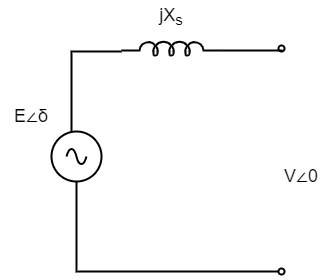
Consider following cases:
Case-I :- When the load is lagging then corresponding phasor diagram is
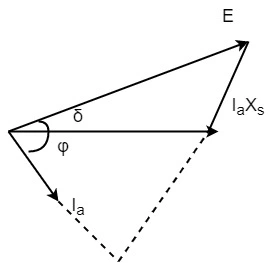
|V| , |E|
Case-II :- When the load is leading , the corresponding phasor diagram is
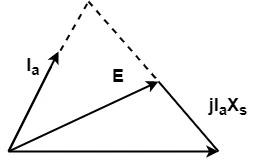
|V| > |E|
A cylindrical rotor synchronous generator (with Ra=0) always has positive voltage regulation for lagging p.f loads i.e. EA > VA . While When there is negative voltage regulation for leading loads then EA>VA, EA=VA and EA , VA can be possible.
Q. 8 A lossless transmission line with 0.2 pu reactance per phase uniformly distributed along the length of the line, connecting a generator bus to a load bus, is protected up to 80 % of its length by a distance relay placed at the generator bus. The generator terminal voltage is 1 pu. There is no generation at the load bus. The threshold pu current for operation of the distance relay for a solid three phase-to ground fault on the transmission line is closest to:
(A) 1.00
(B) 3.61
(C) 5.00
(D) 6.25
Ans. (D) 6.25
Solution: We know that in general, the current is the reciprocal of impedance
I_pu = frac{1}{Z_TH}It is given that ZTh = 0.2
Let us assume two cases
Case-I :- For 100% of line
= frac{1}{0.2}= 5 pu for 100% of the line .
Case-II : For 80% of line
It is given that the relay is operated for 80%
I_pu = frac{1}{Z_pu}i.e. Zpu=0.8 , Zp.u= 0.8 x 0.2 = 0.16 p.u
Now,= frac{1}{0.16}= 6.25 pu
So, option (d) is correct.
Q. 9 Out of the following options, the most relevant information needed to specify the real power (P) at the PV buses in a load flow analysis is
(A) solution of economic load dispatch
(B) rated power output of the generator
(C) rated voltage of the generator
(D) base power of the generator
Ans. (A) solution of economic load dispatch
Solution: The most relevant information needed to specify the real power (P) at the PV buses in a load flow analysis is the solution of economic load dispatch .Economic load diospatch is a precursor to the load study (LFS) i.e to perform the LFS the first step is to perform the economic load dispatch.
The economic load dispatch means the real and reactive power of the generator varies within certain limits and fulfills the load demand with less fuel cost. The online load dispatch distributes the load among the generating unit whichis parallel to the system in such a manner as to reduce the total cost of supplying.
Q. 10 Consider a linear time-invariant system whose input r(t) and output y(t) are related by the following differential equation:
frac{d^{2}y(t)}{dt^{2}}+4y(t)=6r(t)The poles of this system are at
(A) +2j, -2j
(B) +2,-2
(C) +4,-4
(D) +4j, -4j
Ans. (A) +2j, -2j
Solution:
Q.11 A single-phase, full-bridge diode rectifier fed from a 230 V, 50 Hz sinusoidal source supplies a series combination of finite resistance, R, and a very large inductance, L. The two most dominant frequency components in the source current are:
(A) 50 Hz, 0 Hz
(B) 50 Hz, 100 Hz
(C) 50 Hz, 150 Hz
(D) 150 Hz, 250 Hz
Ans. (C) 50 Hz, 150 Hz
Solution: Given that , f=50 Hz, V= 230 V , The full bridge rectifier is the combination of resistance R, and large inductance L . So the two dominating frequency components are that frequency f=50 Hz and f=150 Hz
Q. 12 Thyristor T1 is triggered at an angle α (in degree), and T2, at angle 180° + α, in each cycle of the sinusoidal input voltage. Assume both thyristors to be ideal. To control the load power over the range 0 to 2 kW, the minimum range of variation in α is:
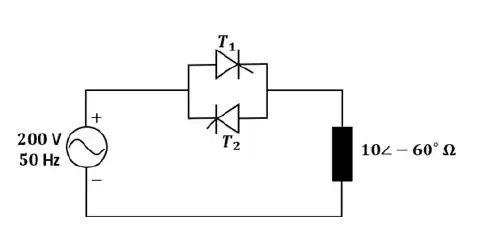
(A) 0° to 60°
(B) 0° to 120°
(C) 60° to 120°
(D) 60° to 180°
Ans. (d)
Solution: Here the given circuit is a single-phase full wave AC voltage controller
The load given is 10 ∠ 60o
Load angle (φ) =60o
The load is inductive therefore in inductive load thecurrent is lagging the voltage by 60o.
Therefore, it is possible to have control for a range of 60o to 180o .
So, option (d) is correct.
Q.13 Which of the options is an equivalent representation of the signal flow graph shown here?
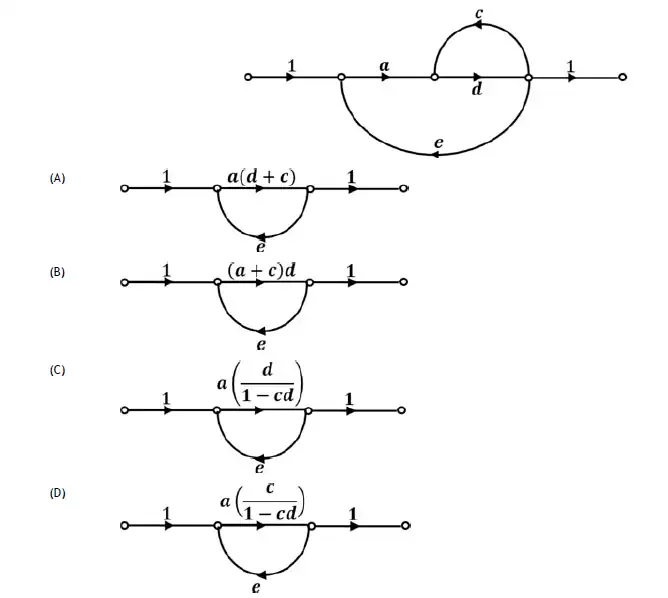
Ans. (C)
Solution: The given signal flow graph is
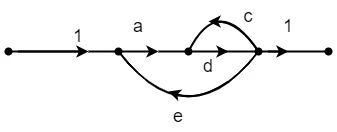
Let us simplify the given signal flow graph
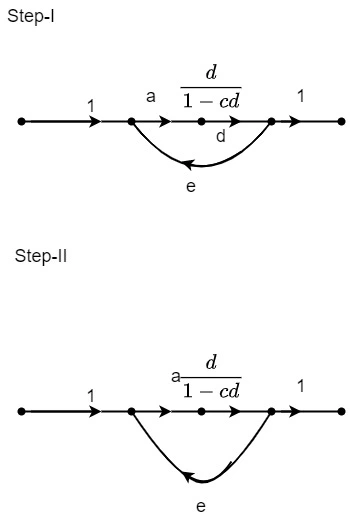
In step 2 we have added the 2 and 3 point
Therefore, a+ frac{d}{1-cd}
So, option (d) is correct.
Q.14 A common-source amplifier with a drain resistance, RD = 4.7 kΩ., is powered using a 10 V power supply. Assuming that the transconductance, gm, is 520 μA/V, the voltage gain of the amplifier is closest to:
(A) -2.44
(B) -1.22
(C) 1.22
(D) 2.44
Ans. (A) -2.44
Solution:
Q. 15 A sequence detector is designed to detect precisely 3 digital inputs, with overlapping sequences detectable. For the sequence (1,0,1) and input data (1,1,0,1,0,0,1,1,0,1,0,1,1,0), what is the output of this detector?
(A) 1,1,0,0,0,0,1,1,0,1,0,0
(B) 0,1,0,0,0,0,0,1,0,1,0,0
(C) 0,1,0,0,0,0,0,1,0,1,1,0
(D) 0,1,0,0,0,0,0,0,1,0,0,0
Ans. (B) 0,1,0,0,0,0,0,1,0,1,0,0
Solution: The limitations of Sequence detector are
i) In case of non-overlapping sequence detector, the pattern 101 appears 2 times in the given bit sequebnce.
ii) In case of overlapping sequence detector, the pattern 101 is appearing 3 times in given bit sequence
So, the output of detector will be 0,1,0,0,0,0,0,1,0,1,0,0
So, option (b) is correct.
Q.16 Consider the initial value problem below. The value of y at x = ln 2, (rounded off to 3 decimal places) is __.
frac{dy}{dx}= 2x-y y(0)=1
Ans. 0.8774 to 0.8952
Solution: We know that the standard form of differential equation is,
frac{dy}{dx}+Py=QWhere, P and Q arethe functions of x
Comparing the given equation with the standard equation
frac{dy}{dx}=2x-yy(0) = 1, y at x= ln 2
Adjusting the given equation in standard form,
frac{dy}{dx}+y=2xHere, P=1 and Q=2x
Now let us calculate the integrating factor,
IF(Integrating factor) = e^{int P dx}
The solution of above differential equation is
y(IF) = int {IF}. Q dx
Y(IF) = int Q(IF)dx
yex = int 2x.(e^x)dx = 2(xex-ex)+C
y=2(x-1)+ Ce-x
y=2x-2+ce-x –(i)
y(0)=1
Putting this value in eq.(i)
1=0-2+C
C=3
y=2x-2+3e-x
Replacing value of x = ln2
y=2(ln2) – 2 + 3e-ln2
y = 1.386 – 2 + frac{3}{2}
y=0.866
Q. 17 A three-phase, 50 Hz, 4-pole induction motor runs at no-load with a slip of 1 %. With full load, the slip increases to 5 %. The % speed regulation of the motor (rounded off to 2 decimal places) is _.
Ans. 4.10 to 4.40
Solution: In the given induction motor , there are 4 poles
and Synchronous speed (Ns) = 1500
Let us consider following cases,
Case-I :- Pole = 4 , f = 50 Hz , Induction motor has a slip of 1 %
Speed at no load is
No = Ns(1-s)
No = 1500(1-0.01) = 1485
Case-II :- Pole = 4 , f=50 Hz , Induction motor has full load slip is 5 %
Speed at full load is
N = 1500(1-0.05) = 1425
Now, Calculating the Speed Regulation
% Speed ; Regulation = frac{N_{o}-N}{N}times 100 = frac{1485-1425}{1425}times 100% Speed Regulation = 4.21 %
Q. 18 Currents through ammeters A2 and A3 in the figure are 1∠10° and 1∠70°, respectively. The reading of the ammeter A1 (rounded off to 3 decimal places) is __ A.
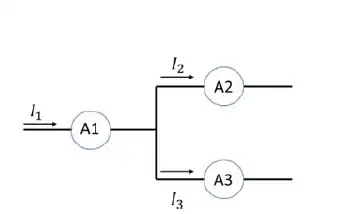
Ans. 1.700 to 1.750
Solution: Let I is the resultant current and it is the sum of I1 and I2
I= I1 + I2
I1 = 1 ∠10o
I2= 1∠70o
I= 1 ∠10o + 1 ∠70o
I = 1.732 ∠40o
The reading of ammeter A1 is 1.732 A
Q. 19 The Thevenin equivalent voltage, VTH, in V (rounded off to 2 decimal places) of the network shown below, is __.
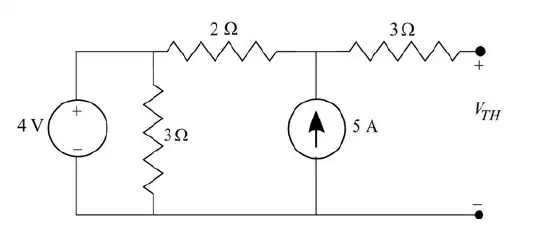
Ans. 13.80 to 14.20
Solution: The given circuit is

We lnow the ohm’s law
V= IR ,
Here we will take Thevenin’s vale of current to finfd the thevenin’s voltage
frac{V_{th}-V}{R}=I frac{V_{th}-4}{2}=5Vth = 14 V
Q. 20 A double pulse measurement for an inductively loaded circuit controlled by the IGBT switch is carried out to evaluate the reverse recovery characteristics of the diode, D, represented approximately as a piecewise linear plot of current vs time at diode turn-off. Lpar is a parasitic inductance due to the wiring of the circuit, and is in series with the diode. The point on the plot (indicate your choice by entering 1, 2, 3 or 4) at which the IGBT experiences the highest current stress is __.
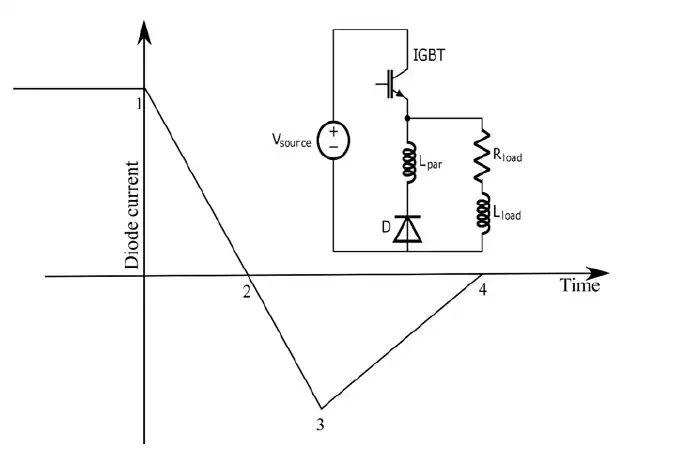
Ans. 3 to 3
Solution: We can say that at point 3 the IGBT experiences the highest current stress.
Q. 21 A single-phase, 4 kVA, 200 V/100 V, 50 Hz transformer with laminated CRGO steel core has rated no-load loss of 450 W. When the high-voltage winding is excited with 160 V, 40 Hz sinusoidal ac supply, the no-load losses are found to be 320 W. When the high-voltage winding of the same transformer is supplied from a 100 V, 25 Hz sinusoidal ac source, the no-load losses will be __W (rounded off to 2 decimal places).
Ans. 162.41 to 162.59
Solution: Given is the single phase transformer with reading as 4 KVA, 200 V/100 V , f=50 Hz , V1= 200 V , V2= 100 V ,
i) When V= 200 V , f= 50 Hz , Pc = 450 W
ii) When V= 160 V , f= 40 Hz , Pc = 320 W
iii) When V= 100 V , f= 25 Hz , Pc= ? watt
Here, frac{V}{f} = Constant = frac{200}{50} = frac{160}{40} = frac{100}{25}
In general
Pc = At + Bt2
Let us put f= 50 Hz , in first case
and f= 40 Hz , in second case
450 = A x (50) + B x (50)2 —(i)
320 = A x (40) + B x (40)2 –(ii)
From eq. (i) and (ii) we get ,
frac{450}{50} = A + B(50) —(iii)
frac{320}{40} = A + B(40) —(iv)
By simultaneously solving eq. (iii) and (iv)
(9-8) = B(10)
B= 1/10
and A = 9 – 1/10 x 50 = 4
Now talking third case where V= 100 V , f= 25 Hz ,
Pc = 4 x 25 + 1/10 x (25)2 = 100 + 62.5 = 162. 50 Watt
Pc = 162.50 Watt
So, the no load losses will be 162.50 Watt .
Q.22 A single-phase inverter is fed from a 100 V dc source and is controlled using a quasi-square wave modulation scheme to produce an output waveform, v(t), as shown. The angle o is adjusted to entirely eliminate the 3rd harmonic component from the output voltage. Under this condition, for v(t), the magnitude of the 5th harmonic component as a percentage of the magnitude of the fundamental component is __ (rounded off to 2 decimal places).
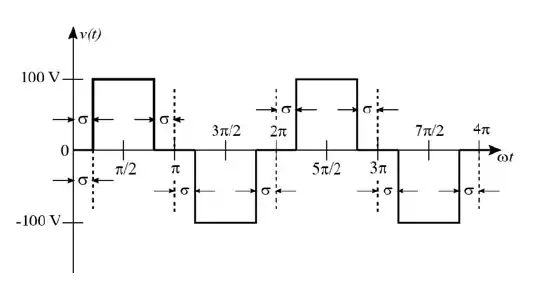
Ans. 19.90 to 20.20
Solution: The given quasi square waveform is
V_{n}=frac{4V}{npi }cos nsigmaGiven that , magnitude of 3rd harmonic component
V3= frac{4V}{3pi }cos nsigma
cos n σ =0
cos (3σ)=0
σ= π/6
Similarly the magnitude of 5th harmonic component from the output voltage is
V5= frac{4V}{5pi }cos nsigma
Now th magnitude of the fundamental harmonic component from the output voltage is
V1= frac{4V}{pi }cos frac{pi}{6}
Now dividing the magnitude of fundamental harmonic component and the fifth harmonic component we get
frac{V_{5}}{V_{1}}=frac{frac{4V_{s}}{pi }cos frac{5pi }{6}}{frac{4V_{s}}{pi }cos frac{5pi }{6}}= -0.2Taking magnitude of this we get
%|frac{V_{s}}{V_{1}}|=20%The magnitude of the 5th harmonic component as a percentage of the magnitude of the fundamental component is 20%.
Q. 23 A single 50 Hz synchronous generator on droop control was delivering 100 MW power to a system. Due to increase in load, generator power had to be increased by 10 MW, as a result of which, system frequency dropped to 49.75 Hz. Further increase in load in the system resulted in a frequency of 49.25 Hz. At this condition, the power in MW supplied by the generator is _(rounded off to 2 decimal places).
Ans. 123.00 to 135.00
Solution: Let us consider the full load frequency as 50 Hz
Let us write equation at 110 MW
tan θ = frac{50-49.75}{110-100}=frac{49.75-49.25}{(x-(110))}
Now again writing equation at x MW
frac{0.25}{10}=frac{0.5}{(x-150)}x – 110 = frac{0.5times10}{0.25}
x = 110 + 20 = 130 MW
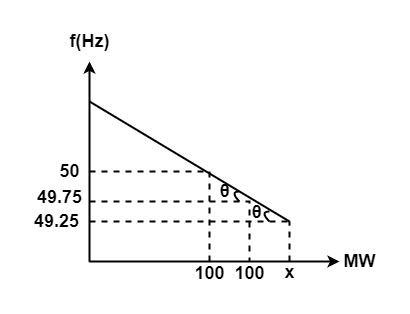
Q.24 Consider a negative unity feedback system with forward path transfer function
G(s)=frac{K}{(s+a)(s-b)(s+c)} where K, a,b,c are positive real numbers.
For a Nyquist path enclosing the entire imaginary axis and right half of the s-plane in the clockwise direction, the Nyquist plot of (1 +G(s)), encircles the origin of (1 +G(s))-plane once in the clockwise direction and never passes through this origin for a certain value of K. Then, the number of poles of frac{G(s)}{1+G(s)} lying in the open right half of the s-plane is _.
Ans. 2 to 2
Solution: The open loop trasnfer function is given
O.L.T.F. = G(s) = frac k{left(s+aright)left(s-bright)left(s+cright)}
The open loop poles on right half of s plane is P=1
N = P – Z; P = 1
The closed loop in the open right of s plane is Z= P-N
-1 = 1 – Z; N = -1
Z = 2
So , the answer will be 2.
Q.25 The cross-section of a metal-oxide-semiconductor structure is shown schematically. Starting from an uncharged condition, a bias of +3 V is applied to the gate contact with respect to the body contact. The charge inside the silicon dioxide layer is then measured to be +Q. The total charge contained within the dashed box shown, upon application of bias, expressed as a multiple of (absolute value in Coulombs, rounded off to the nearest integer) is _.
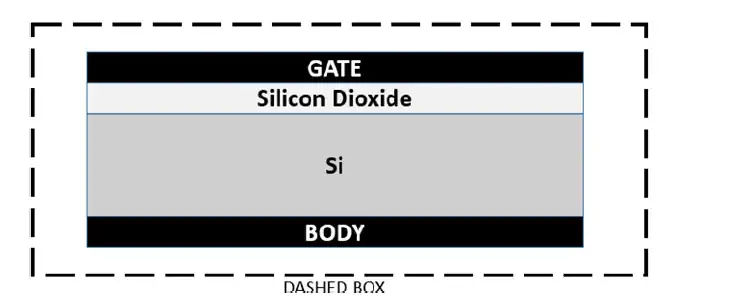
Ans. 0 to 0
Solution: The given diagram can be simplified as,
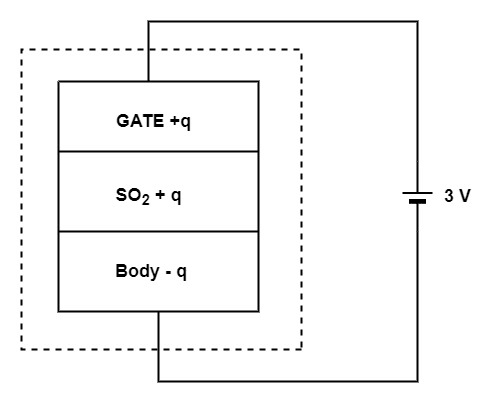
Overall charge in side the box q + q – q = 0 charge
Therefore, the total charge is 0.
Q.26 For real numbers, x and y, with y = 3x2 + 3x + 1, the maximum and minimum value of y for x ∈ [-2,0] are respectively,
(A) 7 and 1/4
(B) 7 and 1
(C) -2 and -1/2
(D) 1 and 1/4
Ans. (A) 7 and 1/4
Solution: Let f be the real valued function and c be an interior point in the domain of f siuch that f’c=0
The given function is
y = 3x2 + 3x + 1 in [-2, 0]
frac{partial y}{partial x}=6x+3, frac{partial y}{partial x}=6
frac{dy}{dx}=06x + 3 =0
x=frac{-1}2We know that, for a global maximum and minimum values we should consider the extreme points along with critical points.
frac{d^2y}{dx^2}= 6 > 0 minimum
Maximum value of y in [-2,0] is maximum {f(-2),f(0)}
max {7, 1} = 7
Minimum value of y in [-2, 0]
minbegin{bmatrix}f(-2)&f(0)&fleft(frac12right)\downarrow&downarrow&downarrow\7&1¼end{bmatrix}+=frac14Maximum value is 7, minimum value is frac14 .
So, option (a) is the correct answer
Q. 27 The vector function expressed by
F = ax (5y – kız) + ay (3z+k2x) + az (k3y – 4x)
represents a conservative field, where ax, ay, az, are unit vectors along x, y and z directions, respectively. The values of constants k1, k2,k3 are given by:
(A) k1 = 3, k2 = 3, k3 = 7
(B) k1 = 3, k2 = 8, k3 = 5
(C) k1 = 4, k2 = 5, k3 = 3
(D) k1 = 0, k2= 0, k3= 0
Ans. (C) k1 = 4, k2 = 5, k3 = 3
Solution: It is given that the,
overline F=(5y-k_1z)widehat i+(3z+k_2x)widehat j+(k_3y-4x)widehat k is conservation field
We know that, overline F is irrotational, ∇ × F = 0
begin{bmatrix}widehat i&widehat j&widehat k\fracpartial{partial x}&fracpartial{partial y}&\fracpartial{partial z}\5y-k_1z&3z+k_2x&k_3y-4xend{bmatrix}=0 widehat i(k_3-3)-widehat j(-4+k_1)+widehat k(k_2-5)=0k3 -3 = 0 4- k1 = 0 k2 – 5 = 0
k3 = 3 k1 = 4 k2 = 5
k1 = 4 k2 = 5 k3 = 3
Therefore, the required values are, k1=4, k2=5, k3=3
Q. 28 A 250 V dc shunt motor has an armature resistance of 0.22 and a field resistance of 100 Ω. When the motor is operated on no-load at rated voltage, it draws an armature current of 5 A and runs at 1200 rpm. When a load is coupled to the motor, it draws total line current of 50 A at rated voltage, with a 5 % reduction in the air-gap flux due to armature reaction. Voltage drop across the brushes can be taken as 1 V per brush under all operating conditions. The speed of the motor, in rpm, under this loaded condition, is closest to:
(A) 1200
(B) 1000
(C) 1200
(D) 900
Ans. (C) 1200
Solution: Given that at no load condition, the armature current Ia1= 5A
The no load speed , N1 = 1200 rpm , Brush drop = 1 V per brush
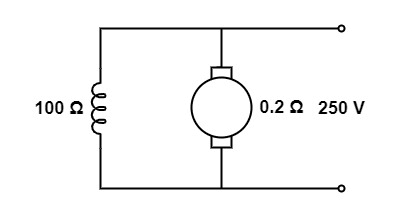
loaded IL = 50 A
Rsh = 100 Ω
ISH = frac{250}{100} = 2.5 A
Ia0 = 2.5 A
IaL = 47.5 A
V = Eb + IaRa + B.R.D
Eb no load = V – Ia0Ra -B.R.D
= 250 – 2.5(0.2) – 1 × 2
= 247.5 Volts
Eb load = 250 – 47.5(0.2)- 1 × 2
= 238.5 Volts
frac{N_2}{N_1}=frac{E_{b2}}{E_{b1}}timesfrac{phi_1}{phi_2} frac{N_2}{1200}=frac{238.5}{247.5}timesfrac{phi_1}{0.95phi_1}N2= 1219.68 rpm
Q.29. Two buses, i and j, are connected with a transmission line of admittance Y, at the two ends of which there are ideal transformers with turns ratios as shown. Bus admittance matrix for the system is:

(A) begin{bmatrix} -t_{i}t_{j} Y& t_{j}^{2}Y t_{i}^{2}Y& -t_{i}t_{j} Yend{bmatrix}
(B) begin{bmatrix} t_{i}t_{j} Y& -t_{j}^{2}Y -t_{i}^{2}Y& t_{i}t_{j} Yend{bmatrix}
(C) begin{bmatrix} t_{i}^{2}Y& -t_{i}t_{j}Y -t_{i}t_{j}Y & t_{j}^{2} Yend{bmatrix}
(D) begin{bmatrix} t_{i}t_{j}Y & -(t_{i}-t_{j})^{2}Y -(t_{i}-t_{j})^{2}Y & t_{i}t_{j}Yend{bmatrix}
Ans. (C) begin{bmatrix} -t_{i}^{2}Y& -t_{i}t_{j}Y -t_{i}t_{j}Y & t_{j}^{2} Yend{bmatrix}
Solution: The Bus admittance matrix is given by ,
begin{bmatrix}I_{i}\I_{j}end{bmatrix}=begin{bmatrix} Y_{11} & Y_{ij}\Y_{ji}& Y_{jj}end{bmatrix}begin{bmatrix} V_{i}\V_{j}end{bmatrix}In simple , it is I = YV
Given that the two buses i and j are connected with the transmission line having admittance Y, at the two ends of which there are ideal transformers with turns ratio 1 : ti and 1: tj
From the circuit , we get that
frac{I_{i}}{t_{i}}=(V_{i}t_{i}-V_{j}t_{j})YIi = (ti2.Y)Vi – (-titj.Y)Vj —(i)
Similarly for j we can write
frac{I_{j}}{t_{j}}=(V_{j}t_{j}-V_{i}t_{i})YIj = (-titj.Y)Vi-Vj(tj2.Y) —(ii)
From eq. (1) and (ii) we get matrix as,
begin{bmatrix} -t_{i}^{2}Y& -t_{i}t_{j}Y\ -t_{i}t_{j}Y & t_{j}^{2} Yend{bmatrix}Q. 30 Consider the diode circuit shown below. The diode, D, obeys the current-voltage characteristic I_{D}=I_{S}left ( expleft ( frac{V_{D}}{nV_{T}} right )-1 right ) where n > 1, VT> 0, VD is the voltage across the diode and lD is the current through it. The circuit is biased so that voltage, V > O and current, I < 0. If you had to design this circuit to transfer maximum power from the current source (II) to a resistive load (not shown) at the output, what values of R1 and R2 would you choose?

(A) Large R1 and large R2.
(B) Small R1 and small R2.
(C) Large R1, and small R2.
(D) Small R1, and large R2.
Ans. (D) Small R1, and large R2.
Solution: Let VD is the voltage across the diode, so by using voltage division rule, we get
V_D=Vtimesfrac{R_2}{R_1+R_2} ( When R1, low, R2 high)
If R2 is large Vd (high)
R is less VD = V
Therefore to transfer maximum power R1 should be small and R2 is large.
Q. 31 A non-ideal diode is biased with a voltage of -0.03 V, and a diode current of 11 is measured. The thermal voltage is 26 mV and the ideality factor for the diode is 15/13. The voltage, in V, at which the measured current increases to 1.51is closest to:
(A) -0.02
(B) -0.09
(C) -1.50
(D)-4.50
Ans. (B) -0.09
Solution: We know that the current across the diode is given by,
I=I_{o}left ( e^{frac{V_{D}}{eta V_{T}}} -1right )Here, VD = applied voltage
VT= Thermal voltage
η= Ideality factor
So,
I_D=I_{o}left ( e^{frac{V_{D}}{eta V_{T}}} -1right )ID1=I1 , ID2=1.5I1
VD=-0.03 , η=15/13, VT= 26 mV
η x VT = frac{15|{13} x 26 x 10-3 = 0.03
frac{I_{D2}}{I_{D1}}=frac{{e^frac{VD_{2}}{eta V_{T}}-1}}{e^frac{VD_{1}}{eta V_{T}}-1} frac{1.5times I_{1}}{I_{1}}=frac{{e^frac{VD_{2}}{0.03}-1}}{e^frac{-0.03}{0.03}-1}1.5 x -0.6321 = e^{frac{V_{D2}}{0.03}-1}
-0.9481+1 = e^{frac{V_{D2}}{0.03}
0.0518 = e^{frac{V_{D2}}{0.03}</p> <p>Taking log on both sides</p> <div style="height:10px" aria-hidden="true" class="wp-block-spacer"></div> <p>ln 0.0518 = [katex] {frac{V_{D2}}{0.03}
VD2 = -2.9599 x 0.03 = -0.09
The voltage at which current increases to 1.5 I1 is -0.09 V
Q. 32 A benchtop dc power supply acts as an ideal 4 A current source as long as its terminal voltage is below 10 V. Beyond this point, it begins to behave as an ideal 10 V voltage source for all load currents going down to 0 A. When connected to an ideal rheostat, find the load resistance value at which maximum power is transferred, and the corresponding load voltage and current.
(A) Short, ∞ A, 10 V
(B) Open, 4 A, 0 V
(C) 2.5 12,4 A, 10 V
(D) 2.5Ω,4 A, 5 V
Ans. (C) 2.5 12,4 A, 10 V
Solution: Let us assume the following cases,
Case -I :- When the supply acts as 4 A current source,
So, V= IR = 4 x R
We know that , P= I2R = 42R
Vmax = 10 V , Rmin= Vmax/I = 10/4 = 2.5 Ω
Pmax = I2R = 42 x 2.5 = 16 x 2.5 = 40 W
Case-II :- When the supply acts as a 10 V source and R > 2.5 Ω
I= frac{10}{R},
P= frac{10^2}{R}= frac{10^2}{2.5}=40 W
Therefore, R=2.5 Ω , I=4 A , V= 10 V
Hence, option (c) is correct.
Q.33 The static electric field inside a dielectric medium with relative permittivity, εr = 2.25, expressed in cylindrical coordinate system is given by the following expression
E = ar 2r + aφ ( frac{3}{r}) + az 6
where ar, aφ, az, are unit vectors along r, φ and z directions, respectively. If the above expression represents a valid electrostatic field inside the medium, then the volume charge density associated with this field in terms of free space permittivity, ε0, in SI units is given by:
(A) 3ε0
(B) 4ε0
(C) 5ε0
(D) 9ε0
Ans. (D) 9ε0
Solution:
Given data is the relative permeability is 2.25 and ar, aφ, az, are unit vectors along r, φ and z directions
overrightarrow D=inoverrightarrow E=in_0in_roverrightarrow E overrightarrow D=in_02.25left(2r{widehat a}r+frac3r{widehat a}phi+6{widehat a}_zright) overrightarrow D=4.5in_0r{widehat a}r+frac{6.75in_0}r{widehat a}phi+13.5in_0{widehat a}_zVolume charge density
rho_v=overrightarrow V.overrightarrow D rho_v=frac1rfracpartial{partial r}left(rD_rright)+frac1rfrac{partial D_phi}{partial_phi}+frac{partial D_z}{partial z} rho_v=frac1rfracpartial{partial r}left(r4.5in_0rright)+frac1rfrac{partial D_phi}{partial_phi}left(frac{6.75in_0}rright)+fracpartial{partial Z}left(13.5in_0right) =frac1rfracpartial{partial r}left(4.5in_0r^2right)+0+0 =frac1rfracpartial{partial r}left(4.5in_0right)left(2rright)=9in_0Therefore, option (d) is correct.
Q.34 Consider a permanent magnet dc (PMDC) motor which is initially at rest. At t = 0, a dc voltage of 5 V is applied to the motor. Its speed monotonically increases from 0 rad/s to 6.32 rad/s in 0.5 s and finally settles to 10 rad/s. Assuming that the armature inductance of the motor is negligible, the transfer function for the motor is
(A) frac{10}{0.5s+1}
(B) frac{2}{0.5s+1}
(C) frac{2}{s+0.5}
(D) frac{10}{s+0.5}
Ans. (B) frac{2}{0.5s+1}
Solution: The given input is 5 V
The R(s) = frac{5}{s}
The stahndard transfer function is given by,
frac{C(s)}{R(s)}=T.F=frac{K}{1+Ts} C(s)=frac{5K}{s(1+Ts)}By final value theorem,
Lim_{srightarrow 0}sC(s)=5K=105K=10
K=2
The given steady state speed is 10 rad/sec
The required transfer function is,
C(s) becomes C(s)=frac{2}{1+0.5s}times frac{5}{s}
Lim_{srightarrow 0}sC(s)=10Therefore, the transfer function for the motor is frac{2}{0.5s+1}
So, correct option is (b)
Q.35 Which of the following options is correct for the system shown below?
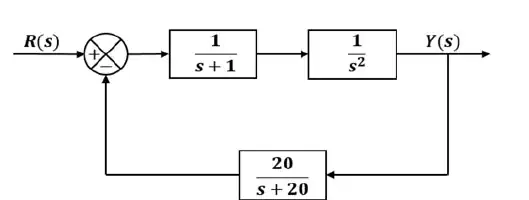
(A) 4th order and stable
(B) 3rd order and stable
(C) 4th order and unstable
(D) 3rd order and unstable
Ans. (C) 4th order and unstable
Solution: From the given figure, we can write equation by adding all the parameters,
1+frac{20}{s^{2}(s+1)(s+20)}=0Solving this equation we get,
(s3+s2)(s+20) +20 = 0
s4 + 20s3+s3+20s2+20 = 0
s4+21s3+20s2+20 = 0
s1 coefficient = 0
From this we can conclude that the system is fourth order system as the highest power is 4 . and it is also unstable.
So, option (c) is correct.
Q. 36 Consider a negative unity feedback system with the forward path transfer function frac{s^{2}+s+1}{s^{3}+2s^{2}+2s+K} , where K is a positive real number. The value of K for which the system will have some of its poles on the imaginary axis is
(A) 9
(B) 8
(C) 7
(D) 6
Ans. (B) 8
Solution:
CE is 1 + G(s)H(s)= 0
⇒ 1+frac{s^2+s+1}{s^3+2s^2+2s+K}=0
⇒ s3 + 3s2 + 3s+ (1 + K) =0
R.H. criteria:
left.begin{array}{c}s^3\s^2s^1end{array}right|begin{array}{c}1\3\9-(1+k)end{array}begin{array}{c}3\(1+k)\0end{array}For marginal stability
9- (1 + k) = 0
⇒ K = 8
Q.37 Suppose for input x(t) a linear time-invariant system with impulse response h(t) produces output y(t), so that x(t) h(t) = y(t). Further, if |x(t)| |h(t)| = z(t), which of the following statements is true?
(A) For all t ∈(-∞,∞), z(t) ≤ y(t)
(B) For some but not all t ∈ (-∞,∞), z(t) ≤y(t)
(C) For all t ∈ (-∞,∞), z(t) ≥ y(t)
(D) For some but not all t ∈ (-∞,∞), z(t) ≥ y(t)
Ans. (C) For all t ∈ (-∞,∞), z(t) ≥ y(t)
Solution: Let the x(t) is the input, y(t) is the output and the impulse response is h(t)
The given convolution is ,
y(t)=x(t) * h(t)
z(t) = |x(t)| x |h(t)|
Let us assume following cases,
Case-I :- When the input is (1,-1) and (1,1) then we get the output as y(t) and z(t)
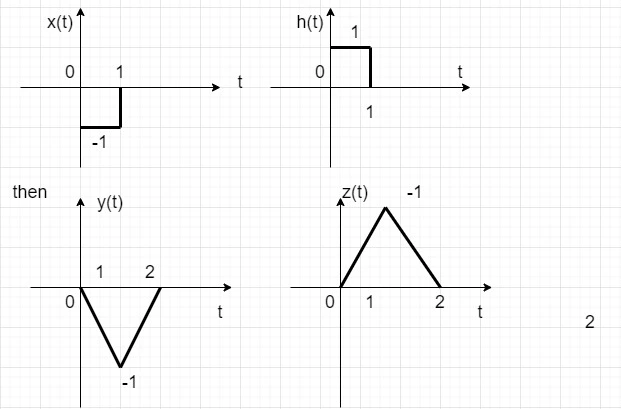
Case-II:- When the input is x(t)= (1,1) and h(t) = (1,1)
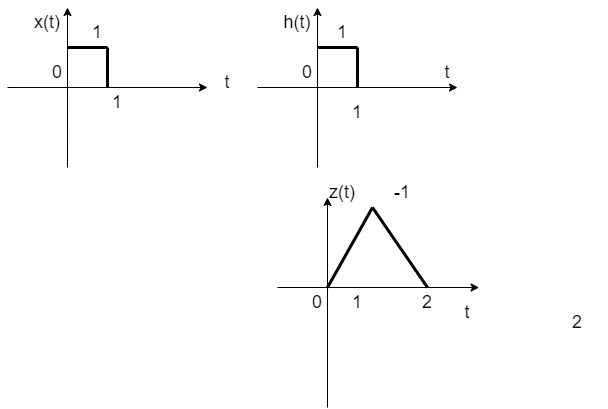
then y(t)=z(t)
Thus, we get z(t)geq y(t) for all't'.
So, option (c) is correct.
Q. 38 The causal realization of a system transfer function H(s) having poles at (2,-1),(-2,1) and zeroes at (2,1),(-2,-1) will be
(A) stable, real, allpass
(B) unstable, complex, allpass
(C) unstable, real, highpass
(D) stable, complex, lowpass
Ans. (B) unstable, complex, allpass
Solution: Given that the Transfer function has poles at (2,-1) , (-2,1)
Zer location is at (2,1) (-2,-1)
From this locations of zeros and poles we infere that filter is al pass because there is mirror image. The mirror image is zero.
The given system is unstable because for stability of causal system all poles should lie on the LHS of s-plane .
But here one pole i.e. (-2,1) lie on the R.H.S
Let us check whether system is simple , complex or real.
H(s)=frac{[s-(2+j)[s-(-2-j)]}{[s-(2+j)[s-(-2+j)]} H(s)=frac{[s-(2+j)[s+2+j)]}{[s-(2-j)[s+(-2-j)]}=frac{s^{2}-(2+j^{2})}{s^{2}-(-2-j)^{2}} frac{s^{2}-3-4j)}{s^{2}-3+4j)}This proves that the function is complex.
So, option (b) is correct.
Q.39 Which of the following options is true for a linear time-invariant discrete time system that obeys the difference equation:
y[n] – ay[n – 1] = box[n] – bıx[n – 1]
(A) y[n] is unaffected by the values of x[n - k] ; k > 2.
(B) The system is necessarily causal.
(C) The system impulse response is non-zero at infinitely many instants.
(D) When x[n] = 0,n< 0, the function y[n]; n > 0 is solely determined by the function x[n].
Ans. (C) The system impulse response is non-zero at infinitely many instants.
Solution:
Q. 40 Let ar, aΦ and az, be unit vectors along r, Φ and z directions, respectively in thecylindrical coordinate system. For the electric flux density given by D= (ar 15+ aΦ 2r - az 3rz) Coulomb/m2, the total electric flux, in Coulomb, emanating from the volume enclosed by a solid cylinder of radius 3 m and height 5 m oriented along the Z-axis with its base at the origin is:
(A) 54π
(B) 90π
(C) 108π
(D) 180π
Ans. (D) 180π
Solution:
⍦/Crossing closed surface = =surfintegraloverrightarrow D.overrightarrow{ds}=iiintleft(overrightarrownabla.overrightarrow Dright)dv
overrightarrownabla.overrightarrow D=frac1rhofracpartial{partialrho}left(rho D_pright)+frac1rhofrac{partial D_phi}{partial_phi}+frac{partial D_z}{partial z} =frac1rhofracpartial{partialrho}left(rho15right)+frac1rhofrac{partial D_phi}{partial_phi}left(2rhoright)+fracpartial{partial z}left(-3rho Zright)=frac1rho15-3rho iiintleft(overrightarrownabla.overrightarrow Dright)dv=iiintleft(frac{15}rho-3pright)rhodrho dphi dz iiint15drho dphi dz-3iiintrho^2drho dphi dz =15int_{rho=0}^3dpint_{phi=0}^{2mathrmpi}dphiint_{z=0}^5-3int_{rho=0}^3rho^2dpint_{phi=0}^{2pi}dphiint_{z=0}^5dz= 15(3-)(2π)(5) -3frac{3^3}3×(2π)(5)
= 45(10π) - 27 (10π)
= 180πC
So, option d is the correct answer.
Q.41 A stable real linear time-invariant system with single pole at p, has a transfer
function H(s) = frac{s^{2}+100}{s-p} with a dc gain of 5. The smallest positive frequency, in rad/s, at unity gain is closest to:
(A) 8.84
(B) 11.08
(C) 78.13
(D) 122.87
Ans. (A) 8.84
Solution:
H(s)=T.F. = frac{s+100}{s-p}
D.C. gain = 5
⇒ frac{100}{-p}=5 = p = -20
H(jomega)=frac{omega^2+100}{jomega+20} left|H(jomega)right|=frac{-omega^2+100}{sqrt{omega^2+400}} frac{-omega^2+100}{sqrt{omega^2+400}}=1⇒ ω = 8.84 rad/sec.
Q.42 The number of purely real elements in a lower triangular representation of the given 3 x 3 matrix, obtained through the given decomposition is _.
begin{bmatrix} 2 & 3 &3 \ 3& 2 &1 \ 3& 1&7 end{bmatrix} = begin{bmatrix}a_{11} & 0 & 0\ a_{12}& a_{22} & 0\ a_{13}&a_{23} & a_{33}end{bmatrix} begin{bmatrix}a_{11} & 0 & 0\ a_{12}& a_{22} & 0\ a_{13}&a_{23} & a_{33}end{bmatrix}^{T}
(a) 6
(b) 5
(c) 8
(d) 9
Ans. (d)
Solution: Given matrix are ,
begin{bmatrix} 2 & 3 &3 \ 3& 2 &1 \ 3& 1&7 end{bmatrix} = begin{bmatrix}a_{11} & 0 & 0\ a_{12}& a_{22} & 0\ a_{13}&a_{23} & a_{33}end{bmatrix} begin{bmatrix}a_{11} & 0 & 0\ a_{12}& a_{22} & 0\ a_{13}&a_{23} & a_{33}end{bmatrix}^{T}
Let the matrix be denoted bu A= IU
So, u11=u22=u33=1
Substituting value of u11,u22,u33
begin{bmatrix} 2 & 3 &3 \ 3& 2 &1 \ 3& 1&7 end{bmatrix} = begin{bmatrix}I_{11} & 0 & 0\ I_{21}& I_{22} & 0\ I_{31}&I_{32} & I_{33}end{bmatrix} begin{bmatrix}1 & u_12 & u_13\ 0& 1 & u_23\ 0&0 & 1end{bmatrix}
begin{bmatrix} 2 & 3 &3 \ 3& 2 &1 \ 3& 1&7 end{bmatrix} = begin{bmatrix}I_{11} & I_{11}u_{12} & I_{11}u_{13}\ I_{21}& I_21u_12+I_{21}u_{13}+I_{22}u_{23} & 0\ I_{31}u_12+I_22&I_{23} & I_{33}end{bmatrix} begin{bmatrix}u_{11} & 0 & 0\ u_{12}& u_{22} & I_31\ I_{31}&I_31u_13+I_{32} & I_31u_I3+I_32u_23+I_{33}end{bmatrix}
I11= 2, I11u12= 3 , I11u13 = 3
I21=3, 2u12 = 3 , 2u13=3
I21u12+I22=2 , I21u13+I22u23 = 1
Now putting all values we get,
I22=-5/2 , u23=7/5
I32= 7/2 , I33=74/10
The matrix obtained through decomposition is
L=begin{bmatrix}2 & 0 & 0\3 & -5/2 & 0\3 & -7/2 & 74/10end{bmatrix}Therefore, the number of real elements of lower triangular matrix are 9.
Q.43 The figure below shows the per-phase Open Circuit Characteristics (measured in V) and Short Circuit Characteristics (measured in A) of a 14 kVA, 400 V, 50 Hz, 4-pole, 3-phase, delta connected alternator, driven at 1500 rpm. The field current, If, is measured in A. Readings taken are marked as respective (x, y) coordinates in the figure. Ratio of the unsaturated and saturated synchronous impedances (Zs(unsat)/Zs(sat)) of the alternator is closest to:
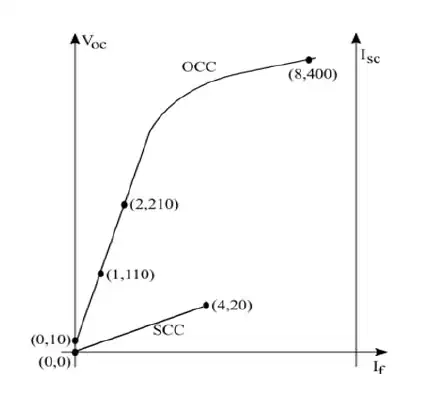
(A) 2.100
(B) 2.025
(C) 2.000
(D) 1.000
Ans. (A) 2.100
Solution: We know that the slope of line is given by,
y=mx+c
m is the slope of the line
Consider two cases
Case-I :- At 400 V , I1=8 A
y=mx+c
y=100x+10 ---(i)
Case-II :- At I1=8A
The unsaturated voltage
y=mx+c = 100 x 8 + 10 = 810
The unsaturated impedance is given by,
Zunsat= frac{810}{20} = frac{81}{2} ---(ii)
The saturated impedance is given by,
Zsat = frac{400}{20} = frac{40}{2} ---(iii)
From eq.(ii) and (iii)
The ratio of unsaturated impedance to the saturated impedance is given by,
frac{Z_{unsaturated}}{Z_{saturated}}=frac{81/2}{40/2}=2.025So, option (a) is correct.
Q. 44 Let ax and ay be unit vectors along x and y directions, respectively. A vector
function is given by F = ax y-ay x
The line integral of the above function int _{c}F.dl along the curve C, which follows the parabola y = x2 as shown below is
__ (rounded off to 2 decimal places).
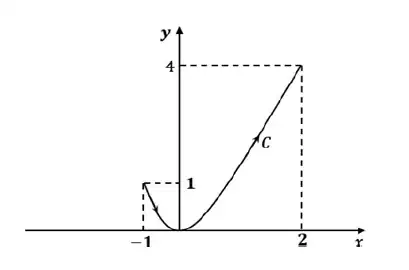
Ans. -3.05 to -2.95
Solution: The given function is
overrightarrow F=y{widehat a}_x-x{widehat a}_y overrightarrow r=xwidehat i+ywidehat j overrightarrow r=xwidehat i-ywidehat j doverrightarrow r=dxwidehat i+dywidehat j =int_cF.doverrightarrow r=int_cF_1dx+F_2dy=int_cydx-xdywhere C is, y = x2
dy = 2x dx
x varies from -1 to 2,
=int_coverrightarrow Fdl=int_{-1}^2x^2dx-x.2xdx=int_{-1}^2left(x^2-2xright)dx =int_{-1}^2-x^2dx=-{left.frac{x^3}3right|}_{-1}^2=-frac83-frac13=-frac93= -3
Q.45 A resistor and a capacitor are connected in series to a 10 V dc supply through a switch. The switch is closed at t = 0, and the capacitor voltage is found to cross 0 V at t = 0.4τ, where τ is the circuit time constant. The absolute value of percentage change required in the initial capacitor voltage if the zero crossing has to happen at t = 0.2τ is (rounded off to 2 decimal places).
Ans. 54.00 to 56.00
Solution:
If initial charge polarities on the capacitor is opposite to the supply voltage then only the capacitor voltage crosses the zero line.
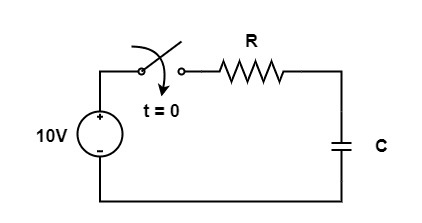
V(t) ⇒ Final value + (Initial value - Final value) e-t/τ
0 = 10 + (-V0 - 10) e-0.4
10 = (V0 + 10) e-0.4
V0 = 4.918 V
Now, t = 0.2 τ
0 = 10 + (-V0' - 10) e-0.2
V'0 = 2.214
Change in voltage = frac{4.918-2.214}{4.918}×100%
= 54.99 %
Q. 46 A cylindrical rotor synchronous generator with constant real power output and constant terminal voltage is supplying 100 A current to a 0.9 lagging power factor load. An ideal reactor is now connected in parallel with the load, as a result of which the total lagging reactive power requirement of the load is twice the previous value while the real power remains unchanged. The armature current is now __A (rounded off to 2 decimal places).
Ans. 123.00 to 127.00
Solution: At constant real power output supplies 100 A current I=100 A
The power factor is cos φ = 0.9
tan φ1 = 0.484 = frac{Q}{P}
frac{2Q}{P} = 0.9686 = tan φ2
cos φ2 = 0.7182
100 x 0.9 = Ia x 0.7182
Ia= 125.29 A
So, the armature current is 125.29 A .
Q.47 Bus 1 with voltage magnitude V1 = 1.1 pu is sending reactive power Q12 towards bus 2 with voltage magnitude V2 = 1 pu through a lossless transmission line of reactance X. Keeping the voltage at bus 2 fixed at 1 pu, magnitude of voltage at bus 1 is changed, so that the reactive power ( 12 sent from bus 1 is increased by 20%. Real power flow through the line under both the conditions is zero. The new value of the voltage magnitude, V1, in pu (rounded off to 2 decimal places), at bus 1 is _.

Ans. 1.11 to 1.13
Solution: We know that the sending send reactive power through a trasnmission line is given by ,
Q_{12}=frac{V_{1}V_{2}}{X}cos (delta )-frac{V_{2}^{2}}{X}V1 is the sending end voltage.
V2 is the receiving end voltage.
X is the reactance of trasnmision line .
δ is the load angle.
Q. 48 Windings 'A', 'B' and 'C' have 20 turns each and are wound on the same iron core as shown, along with winding 'X' which has 2 turns. The figure shows the sense (clockwise/anti-clockwise) of each of the windings only and does not reflect the exact number of turns. If windings 'A', 'B' and 'C' are supplied with balanced 3-phase voltages at 50 Hz and there is no core saturation, the no-load RMS voltage (in V, rounded off to 2 decimal places) across winding 'X' is _.
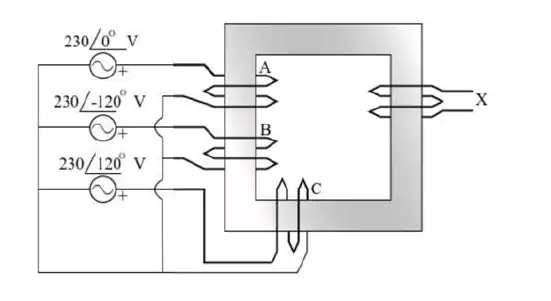
Ans. MTA
Q.49. A cylindrical rotor synchronous generator has steady state synchronous reactance of 0.7 pu and subtransient reactance of 0.2 pu. It is operating at (1 + j0) pu terminal voltage with an internal emf of (1 + j0.7) pu. Following a three-phase solid short circuit fault at the terminal of the generator, the magnitude of the subtransient internal emf (rounded off to 2 decimal places) is __pu.
Ans. 1.01 to 1.03
Solution: The synchronous generator has steady state reactance is Xs= 0.7 pu and subtransient reactance (XT) = 0.2 pu , Let terminal voltage be Et = (1+j0)
The prefault current is given by, Prefault current , Io = frac{E_t-V_t}{jX_d}=frac{1+0.7j-1}{j0.7}=1
Now let us calculate the Subtrasnient induced emf is given by,
E1'' = Vo + jXd''Io
= 1 + j0.2 x 1 = 1+j0.2
|E_1^'|=sqrt{1^2+0.2^2} = 1.02The magnitide of subtransient internal emf is 1.02 pu.
Q. 50 A non-ideal diode is biased with a voltage of –0.03 V, and a diode current of 1 is measured. The thermal voltage is 26 mV and the ideality factor for the diode is 15/13. The voltage, in V, at which the measured current increases to 1.5I1 is closest to:
(a) –4.50
(b) –0.09
(c) –0.02
(d) –1.50
Ans. (b)
Solution: Given an non-ideal diode , Assume terminal voltage as Vo ,
V= -0.03 V , Thermal voltage as VT = 26 mV , ideality factor (α= 15/13)
We know that the current in an non-ideal diode is given as,
I_{1}=I_{o}left [ e^{frac{V}{alpha times V_{T}}} -1right ]=I_{o}left [ e^{frac{0.03}{15/13times 26 mV}} -1right ]The voltage of biased non-ideal diode is negative as . In diode current equation the '1' cannot be neglected
So, again the equation of current becomes
I1= Io[e-30 mV/30 -1] = Io[e-1 - 1] =- 0.64 Io --(i)
So, As per given condition, the current increases to 1.5 I1
1.5 I1 = Io [eV/30 mV - 1]
-1.5 x 0.64 Io = Io [eV/30 mV - 1]
-0.96 = eV'/30 mV - 1
1-0.96 = e V'/30 mV
0.04 = e V'/30 mV
Taking log we get
30 mV ln(0.04) = V'
V' = -0.09 V
Therefore, the voltage in V at which measured current increases to 1.5 I1 is closest to -0.09 V.
So, option (b) is correct.
Q. 51 A stable real linear time-invariant system with single pole at Q.51 p, has a transfer function
H(s)=frac{s^{2}+100}{s-p} with a dc gain of 5. The smallest positive frequency, in rad/s at unity gain is closed to:
(a) 11.08
(b) 78.13
(c) 8.84
(d) 122.87
Ans. (c)
Solution: The given transfer function is H(s)=frac{s^{2}+100}{s-p}
and it has dc gain 5
frac{100}{-p} = 5
p=-20
Let us replace s=j ω
H(jω) = frac{omega^2+100}{jomega+20} --(i)
Taking magnitude of eq.(i)
|H(jomega )|=frac{-omega ^{2}+100}{sqrt{omega ^{2}+400}}frac{-omega ^{2}+100}{sqrt{omega ^{2}+400}} = 1
omega = 8.84 rad/sec
Q. 52 A non-ideal Si-based pn junction diode is tested by sweeping the bias applied across its terminals from -5 V to +5 V. The effective thermal voltage, VT, for the diode is measured to be (29±2) mV. The resolution of the voltage source in the measurement range is 1 mV. The percentage uncertainty (rounded off to 2 decimal places) in the measured current at a bias voltage of 0.02 V is _.
Ans. 11.50 to 12.00
Solution: We know the equation of diode current
I_{D}=I_{o}e^{frac{V_{o}}{eta V_{T}}}Taking log on both the sides
log ID = log Io + log e^{frac{V_{o}}{eta V_{T}}} ---(i)
Let us diferentiate the eq.(i) w.r.t VT
frac{partial I}{I}=0+left ( frac{V_{D}}{eta } right )left ( 1-frac{1}{V_{T}^{2}times partial V_{T}} right ) frac{partial I}{partial V_{T}}=-frac{V_{D}I}{eta V_{T}^{2}}Putting η = 1 , frac{partial I}{partial V_{D}} = [katex] frac{-I}{V_T}
Now the % uncertainity = sqrt{frac{V_{D}^{2}I^{2}}{V_{T}^{4}}W_{VT^{2}}+left [ frac{I}{V_{T}} right ]^{2}W^{2}_{VD}}
Putting values such as VT = (0.029 ± 2 ) mV = (0.029 ± 0.002) V, VD = 0.02 V , WVD=0.001 V, WVT = 0.002 V
Therefore, %frac{W_{res}}{I}=pm 11.7 %
So, 11.7 is the correct option.
Q. 53 The temperature of the coolant oil bath for a transformer is monitored using the circuit shown. It contains a thermistor with a temperature-dependent resistance, Rthermistor = 2 (1 + α T) kΩ, where T is the temperature in °C. The temperature coefficient, α, is -(4± 0.25) %/°C. Circuit parameters: R1 = 1 kΩ, R2 = 1.3 kΩ, R3 = 2.6 kΩ. The error in the output signal (in V, rounded off to 2 decimal places) at 150°C is __.
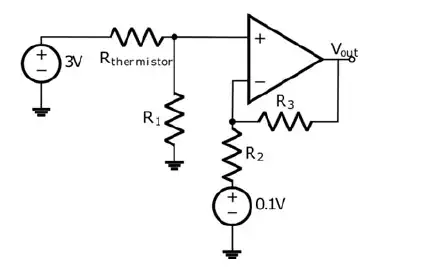
Ans. 0.04
Solution: The given data is as folllows :- Temperature coefficient, α, is -(4± 0.25) %/°C. Circuit parameters: R1 = 1 kΩ, R2 = 1.3 kΩ, R3 = 2.6 kΩ.
Rthermistor = 2 (1 + α T) kΩ,
α, = -(4± 0.25) %/°C = -(0.04 ± 0.0025)oC
From these value we get max and min value of α
αmax = -0.0425/oC , αmin=-0.375/oC
Temperature , T= 150oC
Let us take value of α = 0.04
Now putting these value in equation of thermistor
Rthermistor = Rth = 2(1+αt) = 2 [1-0.004 x 150] = -10 k Ω
The output voltage is given by ,
V_o=V_1times left ( frac{R_{1}}{R_{1}+R_{th}} right )left [ 1+frac{R_{2}}{R_{3}} right ]Vo = 3 x frac{1k}{1k+10k} left [ 1+frac{1.3k}{2.6k} right ]
Vo = 0.5 V
Now, assume the following cases,
Case -1 :- When αmax=-0.0425/oC
The maximum value of thermistor is given by
Rthermax = 2 [1+(-0.0425) x 150 ] kΩ = -10.75 KΩ
Now putting value of Rthma in output voltage
V<sub>o</sub> = V<sub>1</sub> x V_{o}=V_{1}times left ( frac{R_{1}}{R_{1}+R_{th}} right )left [ 1+frac{R_{2}}{R_{3}} right ]Vo = 3 x frac{1k}{1k+10.75k} left [ 1+frac{1.3k}{2.6k} right ]
Vo = 0.46 V
Case -II :- Now let us take the min value of αmin=-0.375/oC
The maximum value of thermistor is given by
Rthermin = 2 [1+(-0.0375) x 150 ] kΩ = -9.25 KΩ
Now putting value of Rthmin in output voltage
V<sub>o</sub> = V<sub>1</sub> x V_{o}=V_{1}times left ( frac{R_{1}}{R_{1}+R_{th}} right )left [ 1+frac{R_{2}}{R_{3}} right ]Vo = 3 x frac{1k}{1k+9.25k} left [ 1+frac{1.3k}{2.6k} right ]
Vo = 0.54 V
The final output voltage is given by , Vo= 0.5 ± 0.04
For calculating the error we will take significant value as error i.e. 0.04
Error = 0.04
The error in the output signal is 0.04
Q. 54 An 8085 microprocessor accesses two memory locations (2001H) and (2002H), that contain 8-bit numbers 98H and B1H, respectively. The following program is executed:
LXI H,2001 H
MVI A, 21H
INXH
ADD M
INX H
MOV M, A
HLT
At the end of this program, the memory location 2003H contains the number in decimal (base 10) form __.
Ans. 210 to 210
Solution: Given are the two memory locations (2001H) and (2002H)
Let us consider one by one line of program
i) LXI, 20001 H
| H | L |
| 20 | 01 |
i) MVI A, 21 H
| A |
| 21 H |
iii) INX H
HL+1
| H | L |
| 20 | 02 |
ADD M
[A] + data at reference of HL pair
21 H + B1 H = D2H [A]
INX H
[HL]+1 = 2002 H + 1 H = 2003 H
MOV M,A = [A] to memory i.e. reference of HL pair
2003 H
HLT = STOP
Here the program ends.
Therefore, In 2003 H the content is D2H
As it is given D2 ⟶ D2
So, at the end of the program , memory location 2003 H contains D2H
Converting this into decimal form
D x 161 + 2 x 160 = 13 x 16 + 2 = 210
Q. 55 A conducting square loop of side length 1 m is placed at a distance of 1 m from a long straight wire carrying a current I = 2 A as shown below. The mutual inductance, in nH (rounded off to 2 decimal places), between the conducting loop and the long wire is __.
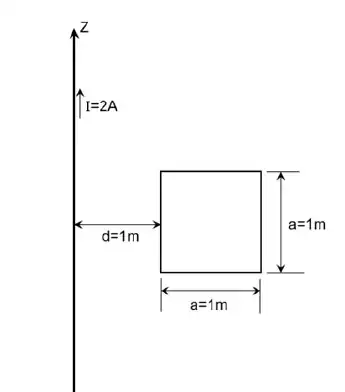
Ans. 138.10 to 139.20
Solution: Given a square loop having length = 1m , It carries current I= 2A
We know that magnetic flux is directly proportional to the current
φ ∝ I
φ = M I
M is the mutual inductance
The magnetic field density is given by ,
overrightarrow{B}=frac{mu {o}I}{2pi rho }hat{a{phi }}overrightarrow{B} is due to the infinite long line
Now, let us calculate the magnetic flux crossing the square loop is,
phi =int int overrightarrow{B}.overrightarrow{ds} phi =int int frac{mu {o}I}{2pi rho }hat{a{phi }}(drho dz)hat{a_{phi }} phi =frac{mu {o}I}{2pi }int{rho =1}^{2}frac{drho }{rho }int_{z=0}^{1}dz phi =frac{mu {o}I}{2pi }(lnrho )^{2}_{rho =1}(z)^{1}_{z=0}Putting all values we get,
phi =frac{mu {o}I}{2pi }(ln2 )And we know that
M=frac{phi }{I} M=frac{mu _{o}ln(2) }{2pi }=frac{4pi times 10^{-7}(ln2)}{2pi }=1.386times 10^{-7 }HM= 1.386 x 10-7 Henry approx 138.63 nH
Therefore, 138.63 is the correct answer.
END OF THE QUESTION PAPER
